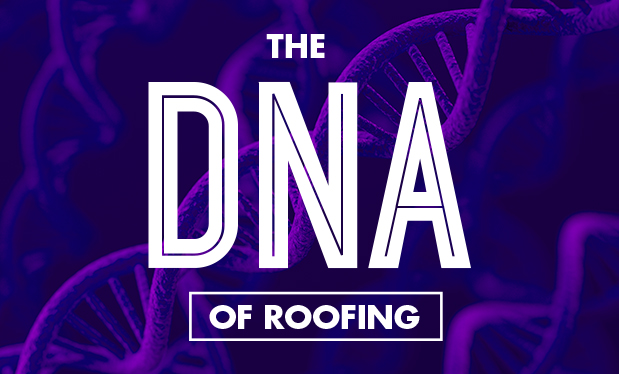With the recent uptick in severe weather, it is important to know how to keep homes protected. Extreme weather is the new normal, so "building as usual" no longer is an option. Homeowners want to know their homes are constructed to withstand wind-driven rain, snow, ice and everything else Mother Nature brings.
When installing or repairing a roof system, it is critical to make sure it is waterproofed properly to prevent future damage and costly repairs. This includes taking steps to prevent and mitigate damage caused by ice dams. The good news is if you understand how ice dams form and know about high-quality products and proper roof system installation methods, you can help protect your customers' homes from the damaging effects of ice dams.
How ice dams form
An ice dam begins to form when warmed air in an attic space, or solar radiation, causes snow on the roof to melt. The water flows down the slope of the roof toward the eave where it refreezes because the eave overhangs unheated space. As the process continues, ice builds up at the eave, forming a dam. Standing water becomes trapped behind the ice dam and can leak into the home or building at fastener penetrations, usually right over an exterior wall.
Ice dams can cause damage and result in necessary, expensive repairs if the standing water behind the dam gets underneath the roof coverings and into the attic and walls. In addition to water leakage, ice dams can severely damage roof coverings, gutters and other roof system components.
Roof system designs should incorporate building materials such as underlayments that limit the formation of ice dams and help prevent leaks caused by ice dams. Underlayments protect roof systems by minimizing leaks caused by ice dams, but they do not prevent ice dams from forming. Roof assemblies designed with proper insulation and adequate ventilation will help limit the formation of ice dams by minimizing the heat transfer from the home's or building's interior to the air in the attic space. The combination of air sealing, insulation and ventilation is crucial.
Minimizing damage
The first step to minimizing the damaging effects of ice dams is to limit the transfer of heat from inside a building to the attic space. This means sealing all air leaks between the attic and living space, as well as ensuring any HVAC ducts located in the attic are well-sealed.
In a ventilated attic, the ceiling also should be generously insulated to limit heat loss to the attic. The attic insulation should not block or interfere with the function of soffit vents. Ventilation of the attic space occurs when air in the attic space is warmed from solar gain, as well as from heat that escapes from the building through attic insulation. The warmed air rises toward the ridge vent where it can escape outside. Cold air is pulled into the attic space through soffit vents, replacing the air that leaves through the ridge vent.
The flow of cold air that moves upward toward the ridge along a roof deck's underside is called a convection current. The convection current helps keep a roof deck cool and slows the ice melting process on the roof surface. Proper roof ventilation and insulation design should be left to a qualified design professional, and care should be taken to comply with local building codes.
However, common roofing practice is to use 1 square foot of net free ventilation area per 150 square feet of attic space split evenly between the ridge and soffit vents. Soffit, ridge, gable or roof deck vents may be used alone or in combination depending on the specific roof design. Soffit and ridge vents used together are an effective, simple and commonly used configuration. Gable vents are sometimes used but usually are not as effective as ridge vents.
It is easy to tell which buildings have roof systems that are well-insulated, ventilated and properly air-sealed. After a snowfall, if snow is melting only from the top half of a roof and an ice dam is forming, heat likely is leaking into the attic space; therefore, the attic is poorly insulated or poorly ventilated.
If snow does not melt or melts evenly over the entire roof slope, the roof system likely has adequate insulation and ventilation to limit ice dam formation. Air sealing, insulation and ventilation will help limit the potential for and severity of ice dams, but these measures may not be effective for limiting the formation of ice dams. For this reason, using a high-quality, self-adhering underlayment in all areas susceptible to ice dams is a critical step.
Self-adhering underlayment
Installing an underlayment membrane underneath shingles protects a roof from water damage caused by ice dams. Roof underlayments perform many functions in a roof system, but first and foremost, they serve as the roof system's last line of defense for homeowners against the damaging effects of water infiltration. Be sure you use a high-quality, self-adhering underlayment to protect your clients' homes from leaks. Although using a self-adhering underlayment at a roof system's eaves is required by building codes in locations where ice dams are common, there are multiple product types that can be used.
It is important to use a self-adhering underlayment, especially at the eaves and at all critical detail areas where snow and ice buildup most commonly lead to leaks. Self-adhering membranes come in a roll form and consist of a layer of adhesive and a surface material, usually either a nonskid film or a granular surface. Not all self-adhering underlayments are the same. Although ASTM D1970, "Standard Specification for Self-Adhering Polymer Modified Bituminous Sheet Materials Used as Steep Roofing Underlayment for Ice Dam Protection," sets forth the building code's minimum requirements for self-adhered underlayments, there can be a wide variation in quality and performance.
Premium performing self-adhering underlayment membranes seal around the fasteners used to attach shingles and other roof coverings, which help prevent the water behind an ice dam from leaking into a building or house. These high-quality, self-adhering underlayments stick to a roof deck so water will not travel under the underlayment and enter a building or house via a vulnerable roof deck joint.
Lastly, self-adhering underlayments seal at overlap areas. Water cannot flow or be blown under well-adhered laps. As a result, self-adhering underlayments provide waterproofing protection unmatched by mechanically attached alternatives, such as roofing felt and synthetic underlayments.
Granular vs. film
Granular-surfaced membranes usually cost less than film-surfaced membranes, but film-surfaced varieties are considered higher-performing products because they form better quality laps. In addition, shingles installed over a film-surfaced underlayment will not adhere to the underlayment surface. Shingles will fuse to the surface of granular-type underlayments, which will result in a more time-consuming job of stripping the underlayment or replacing the decking. Therefore, using a film-surfaced underlayment is likely to result in future roofing projects being completed more easily and at a lower cost.
Proper underlayment installation
In cold regions, you should apply the self-adhering underlayment membrane along the eaves and in all valleys on the roof. Application at the eaves is a requirement of the building code. Additionally, you should protect other critical details and potential trouble spots. Ask your client to point out areas where leaks have occurred in the past and where snow and ice loads were especially high during previous winters.
Roof to wall intersections, chimneys and skylights are frequent problem spots. When self-adhering underlayments are used in full roof coverage applications, adequate ventilation must be provided in the roof assembly design to avoid condensation problems within the roof structure or attic space.
There are two easy ways to install underlayment—the conventional method and back-roll method.
The conventional method
- Cut the membrane into 10- to 15-foot lengths and reroll loosely. Peel back 1 to 2 feet of release liner and align the membrane.
- Peel the release liner from the membrane. Press the membrane in place with heavy hand pressure.
- Minimum overlap guidelines are set by the manufacturer. Grace Residential Building Materials, Cambridge, Mass., requires side laps to be a minimum of 3 1/2 inches and end laps a minimum of 6 inches.
The back-roll method
Some roofing contractors prefer the back-roll method. The back-roll technique can be faster than the conventional method because a roofing worker can install the membrane in just a few minutes.
- Begin by unrolling a 10- to 15-foot piece of membrane, leaving the release liner in place. Align the membrane and roll in the intended direction of the membrane application.
- Carefully cut the release liner on top of the roll in the cross direction, being careful not to cut the membrane.
- Peel back about 6 inches of the release liner in the opposite direction of the intended membrane application, exposing the black adhesive.
- Hold the release liner with one hand and pull the roll along the roof deck with the release liner, leaving the applied membrane behind.
- Stop frequently to press the membrane in place with heavy hand pressure, smoothing the membrane toward the outer edge.
- When finished with the roll, go back and remove the remaining release liner. Smooth the membrane to the edge.
Maximum ultraviolet exposure times vary by product but range from 30 to 180 days depending on product and manufacturer.
Breaking the ice damage
Ice dams can cause damage to buildings, but roofing professionals who understand how ice dams form, choose the best materials and apply them at the proper places can help mitigate damage caused to their customers' homes and buildings.
Dave Baur is product manager for Grace Residential Building Materials, Cambridge, Mass.



